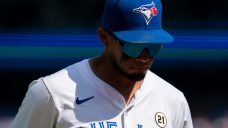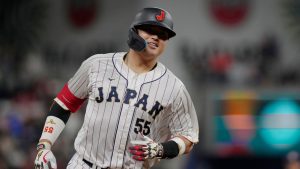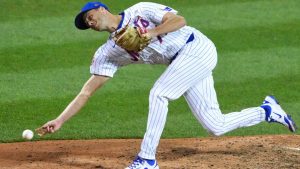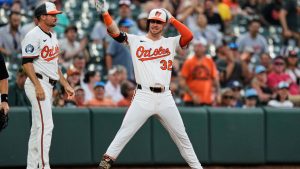TORONTO — Heading into the 2024-25 off-season, the Blue Jays have little choice: to win next year, relievers will have to be an off-season priority.
To say the Toronto bullpen has struggled would be putting it gently. Even after some strong work on the way to a weekend sweep over the Cardinals, Toronto's relievers rank last or close to last in MLB in most important categories, ranking 28th among the 30 teams in ERA (4.78) and strikeout rate (20.3 per cent), 29th in swinging strike rate (10.1 per cent) and 30th in FIP (4.94) and WAR (-2.8). By nearly any measure, this bullpen has been extremely ineffective.
These struggles have happened for a few reasons, including injuries to key players, underperformance from others and a lack of organizational pitching depth that connects back to drafting and development — but understanding the root of these issues is a topic for another day. Now, the question is how the Blue Jays move forward.
"It's giving up less homers, it's walking less guys," manager John Schneider over the weekend. "And then it's just, how do you do that? Is it approach? Is it execution? Those are things we talk about all the time. And in today's game you've got to have some strikeouts. I think that's where we didn't live up to our expectations."
At times, bullpen performance can seem random, and that’s true for single games or even individual player seasons. But Blue Jays relievers have now pitched more than 500 innings this season, and the poor peripherals are telling.
"How can we attack that?" Schneider said. "Do we need to adjust something in terms of how we're viewing guys? But you need guys that can strike guys out, and you've got to be in the zone."
One way or another, significant additions are needed this winter, a reality not lost on team decision makers. The question then becomes how the Blue Jays go about upgrading their bullpen, and the last nine off-seasons offer some significant hints on that front. As a rule, the Blue Jays don’t spend big on free-agent relievers under Mark Shapiro and Ross Atkins, yet if their discipline will ever be put to the test it would be after a season like this.
Until now, the most this front office has guaranteed a free-agent reliever is the $11 million they spent on Yimi García before the 2022 season. They also exercised a significant two-year, $21 million option on Chad Green last off-season and took shots on Kirby Yates ($5.5 million) and Shun Yamaguchi ($6.35 million) a few years ago, but those weren’t huge gambles either.
At no point have the Blue Jays guaranteed a reliever more than two years.
More often, they’ve been notably prudent in free agency, targeting the likes of Tyler Chatwood, J.P. Howell, David Phelps, Seung-hwan Oh, Franklin Morales, Daniel Hudson and Rafael Dolis for $3 million or less.
To be fair, this strategy can work. They had a good bullpen just last year (8th in ERA, 14th in WAR, 1st in K-BB%), for instance. This approach also limits the risk that you’re spending significant money on a player who offers nothing, and allows for greater spending on other needs. When these modest expenditures are paired with impact homegrown arms, good bullpens emerge as teams like the Rays, Guardians and Brewers can attest.
If history repeats itself, then, the Blue Jays will avoid the tempting but risky arms atop the market, signing some relievers on more modest deals that are less likely to backfire.
Of course, there’s another avenue available to them, too. It’s fraught with risk, but the unpredictable pathway exists, too. They could spend.
Top-tier relievers don’t just come with more risk, they deliver higher upside, and that’s especially important in the high-leverage innings the Blue Jays hope to play in 2025. With the season on the line, trusted relievers are a must.
In 2021, their bullpen struggled early and they missed the playoffs on the final day of the season. In 2022, their bullpen blew a seven-run lead in the season’s final game.
They tried to adjust afterwards by trading Teoscar Hernandez for Erik Swanson and sending two prospects to St. Louis for Jordan Hicks, but in doing so they depleted their offence and their farm system. There’s a way to improve your bullpen without doing either — it just means getting uncomfortable financially.
This strategy could be especially appealing at a time that the Blue Jays are light on homegrown relievers. Jordan Romano continues to work his way back from arthroscopic surgery, Tim Mayza has been released and the farm system isn’t producing a clear next generation. Maybe this is the year to make an exception and spend.
Three years for Carlos Estevez or Clay Holmes? Four years for Tanner Scott? Those deals might not age well. Then again, the goal is to win it all, and fighting through four playoff rounds requires elite relief, something the Blue Jays lack and can obtain simply by spending.
By no means is this a must. Ideally, the Blue Jays would thread the needle, spending modestly on just the right additions without compromising their long-term flexibility or limiting their ability to spend on offence this winter. But that strategy comes with a different kind of risk: the risk that the bullpen under-performs again.
After a season like this, the Blue Jays should at least be open-minded. Maybe this is the year to get a little uncomfortable and prepare to offer the right reliever three years or significant dollars to make sure 2025 has a better ending.






